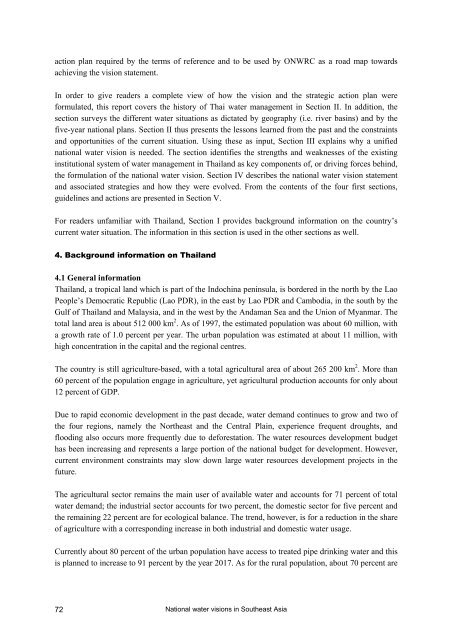The FAO-ESCAP pilot project on national water visions. From vision ...
The FAO-ESCAP pilot project on national water visions. From vision ...
The FAO-ESCAP pilot project on national water visions. From vision ...
You also want an ePaper? Increase the reach of your titles
YUMPU automatically turns print PDFs into web optimized ePapers that Google loves.
acti<strong>on</strong> plan required by the terms of reference and to be used by ONWRC as a road map towards<br />
achieving the visi<strong>on</strong> statement.<br />
In order to give readers a complete view of how the visi<strong>on</strong> and the strategic acti<strong>on</strong> plan were<br />
formulated, this report covers the history of Thai <strong>water</strong> management in Secti<strong>on</strong> II. In additi<strong>on</strong>, the<br />
secti<strong>on</strong> surveys the different <strong>water</strong> situati<strong>on</strong>s as dictated by geography (i.e. river basins) and by the<br />
five-year nati<strong>on</strong>al plans. Secti<strong>on</strong> II thus presents the less<strong>on</strong>s learned from the past and the c<strong>on</strong>straints<br />
and opportunities of the current situati<strong>on</strong>. Using these as input, Secti<strong>on</strong> III explains why a unified<br />
nati<strong>on</strong>al <strong>water</strong> visi<strong>on</strong> is needed. <str<strong>on</strong>g>The</str<strong>on</strong>g> secti<strong>on</strong> identifies the strengths and weaknesses of the existing<br />
instituti<strong>on</strong>al system of <strong>water</strong> management in Thailand as key comp<strong>on</strong>ents of, or driving forces behind,<br />
the formulati<strong>on</strong> of the nati<strong>on</strong>al <strong>water</strong> visi<strong>on</strong>. Secti<strong>on</strong> IV describes the nati<strong>on</strong>al <strong>water</strong> visi<strong>on</strong> statement<br />
and associated strategies and how they were evolved. <strong>From</strong> the c<strong>on</strong>tents of the four first secti<strong>on</strong>s,<br />
guidelines and acti<strong>on</strong>s are presented in Secti<strong>on</strong> V.<br />
For readers unfamiliar with Thailand, Secti<strong>on</strong> I provides background informati<strong>on</strong> <strong>on</strong> the country’s<br />
current <strong>water</strong> situati<strong>on</strong>. <str<strong>on</strong>g>The</str<strong>on</strong>g> informati<strong>on</strong> in this secti<strong>on</strong> is used in the other secti<strong>on</strong>s as well.<br />
4. Background informati<strong>on</strong> <strong>on</strong> Thailand<br />
4.1 General informati<strong>on</strong><br />
Thailand, a tropical land which is part of the Indochina peninsula, is bordered in the north by the Lao<br />
People’s Democratic Republic (Lao PDR), in the east by Lao PDR and Cambodia, in the south by the<br />
Gulf of Thailand and Malaysia, and in the west by the Andaman Sea and the Uni<strong>on</strong> of Myanmar. <str<strong>on</strong>g>The</str<strong>on</strong>g><br />
total land area is about 512 000 km 2 . As of 1997, the estimated populati<strong>on</strong> was about 60 milli<strong>on</strong>, with<br />
a growth rate of 1.0 percent per year. <str<strong>on</strong>g>The</str<strong>on</strong>g> urban populati<strong>on</strong> was estimated at about 11 milli<strong>on</strong>, with<br />
high c<strong>on</strong>centrati<strong>on</strong> in the capital and the regi<strong>on</strong>al centres.<br />
<str<strong>on</strong>g>The</str<strong>on</strong>g> country is still agriculture-based, with a total agricultural area of about 265 200 km 2 . More than<br />
60 percent of the populati<strong>on</strong> engage in agriculture, yet agricultural producti<strong>on</strong> accounts for <strong>on</strong>ly about<br />
12 percent of GDP.<br />
Due to rapid ec<strong>on</strong>omic development in the past decade, <strong>water</strong> demand c<strong>on</strong>tinues to grow and two of<br />
the four regi<strong>on</strong>s, namely the Northeast and the Central Plain, experience frequent droughts, and<br />
flooding also occurs more frequently due to deforestati<strong>on</strong>. <str<strong>on</strong>g>The</str<strong>on</strong>g> <strong>water</strong> resources development budget<br />
has been increasing and represents a large porti<strong>on</strong> of the nati<strong>on</strong>al budget for development. However,<br />
current envir<strong>on</strong>ment c<strong>on</strong>straints may slow down large <strong>water</strong> resources development <str<strong>on</strong>g>project</str<strong>on</strong>g>s in the<br />
future.<br />
<str<strong>on</strong>g>The</str<strong>on</strong>g> agricultural sector remains the main user of available <strong>water</strong> and accounts for 71 percent of total<br />
<strong>water</strong> demand; the industrial sector accounts for two percent, the domestic sector for five percent and<br />
the remaining 22 percent are for ecological balance. <str<strong>on</strong>g>The</str<strong>on</strong>g> trend, however, is for a reducti<strong>on</strong> in the share<br />
of agriculture with a corresp<strong>on</strong>ding increase in both industrial and domestic <strong>water</strong> usage.<br />
Currently about 80 percent of the urban populati<strong>on</strong> have access to treated pipe drinking <strong>water</strong> and this<br />
is planned to increase to 91 percent by the year 2017. As for the rural populati<strong>on</strong>, about 70 percent are<br />
72<br />
Nati<strong>on</strong>al <strong>water</strong> visi<strong>on</strong>s in Southeast Asia
















